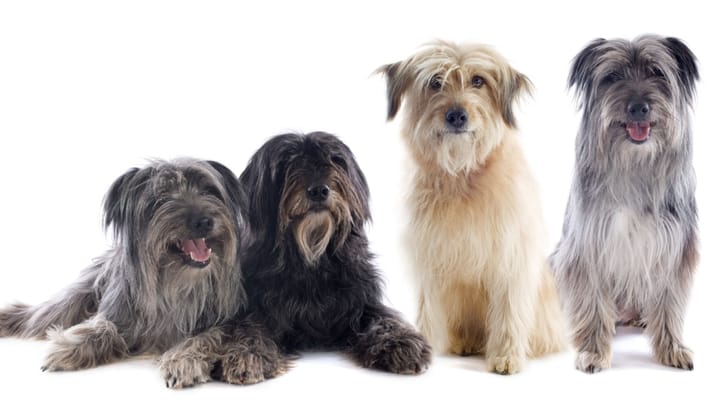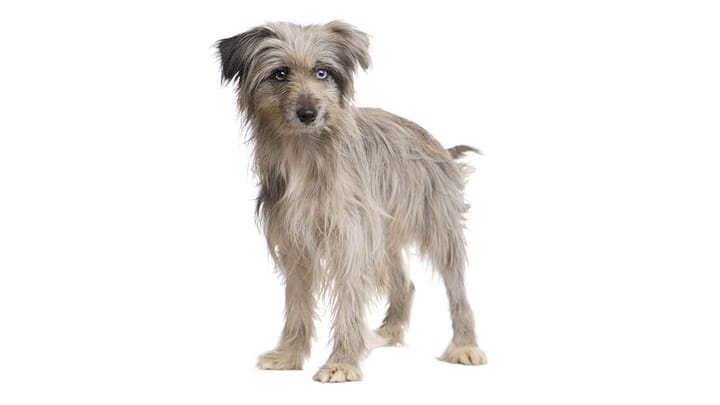Pyrenean Sheepdog
Other names : Berger des Pyrenees, Pastor de los Pirineos, Petit Berger, Pyrenean Shepherd


The Pyrenean Shepherd is an endearing, faithful, very intelligent and active herding dog. He is not intended for owners leading a sedentary life, and requires heaps of exercise and activities to remain content. Not the most docile at times, especially if he does not perceive much intentionality in the orders he gets, this dog needs a firm, fair, and coherent training to fulfil his full potential.
|
Life expectancy |
The Pyrenean Sheepdog has a life expectancy of between 13 and 15 years |
|
Temperament |
|
|
Size |
Small
|
|
Adult size |
Female
Between 16 and 20 in
Male
Between 16 and 21 in
|
|
Adult weight |
Female
Between 18 and 22 lb
Male
Between 18 and 22 lb
|
|
Coat colour
The coat can be a solid colour: every shade of grey and fawn, or black. For the black Pyrenean dogs, considerable patching is authorised, whereas in the case of other colours, the patching must be limited. There also exists some cases of harlequin (variegated blue-black) as well as brindle colouring. Despite a certain consumer interest in the white Pyrenean Shepherd, white coats are not admitted by official standards, and considered a shortcoming. |
Black Blue |
|
Type of coat
The coat is long or medium-long. Quite luscious, the hair is smooth or slightly wavy in the long-haired variety. Official standards stipulate that the coat texture waver between goat hair and sheep wool. This mix between coarse and wooly hair may entail some strands or cords, they look like little braids. They are usually to be found on the croup, chest, around the elbows and thighs. In the rough-faced variety, the head is covered in short and thin hair, hence where its name comes from. |
Long |
|
Eye colour
The eyes are dark brown. |
Brown
|
|
Purchase price |
The Pyrenean Sheepdog costs approximately 790£ |
During the first world war, Pyrenean Shepherds were used by the army as liaison dogs because of their resourcefulness, adaptability and big intelligence.
More details about the Pyrenean Sheepdog
Pyrenean Sheepdog: Origins and history
These are very old dogs, the oldest, in fact, among all the french Shepherds, but their origins are not known in detail. General theory proposes that their origins and history are the same as all the other European Shepherd- that is, that they are descendants of Asian breeds. It is only in the twenties that the first official standard of the breed was established. This was no easy feat since types vary widely from one valley to the next: the constitution or coat could differ significantly, only the personality remained a stable vector. Ever since, many modifications have been introduced to narrow down and stabilise the standard.
Physical characteristics of the Pyrenean Sheepdog
Pyrenean Shepherds may be small dogs, but they are definitely full of energy. His alert appearance, clever and cautious expression, and his vivid way of carrying himself, make this dog very distinct. The head, in its overall shape, resembles that of a brown bear’s. The skull is averagely developed, almost flat, harmoniously round at the sides. The stop is very modest. The most known and widespread variety by far is the smooth-faced Pyrenean Shepherd: his standard begs to remind us that he is ‘unlike any other’. The muzzle is straight, rather short, slightly conical. The ears are large at the base and their extremities are usually amputated. The rough-faced Pyrenean Shepherd has a slightly longer muzzle than the smooth-faced variety. The torso is robust. The limbs are straight. The tail remains quite short.
FCI classification of the Pyrenean Sheepdog
-
Group 1 - Sheepdogs and Cattledogs (except Swiss Cattledogs)
-
Section 1 : Sheepdogs
Pyrenean Sheepdog: Characteristics
Pyrenean Sheepdog: Behaviour
Training a Pyrenean Sheepdog
Both stubborn and sensitive at the same time, the Pyr Shep is not the most docile of sheepdogs. His size and scoundrel-like appearance often (unfortunately) get him a free pass in certain situations in which it absolutely shouldn’t be the case.
Owners that are too permissive or lenient will procure themselves a little demon dog who will always get his way. His owners must in fact demonstrate strictness coupled with gentleness for best results.
Luckily, this is still an incredible sheepdog who- with a precocious, firm, coherent and steady education- will love to obey and please his master.
As soon as the Pyrenean Shepherd pup integrates the home, certain rules of conduct must be implemented to avoid bad habits from developing.
Last but not least, the training process will be greatly enriched by meeting the dog’s various expenditure needs. If his energy is not channeled, it is futile to hope for a functioning cooperation with this little sheepdog.
Pyrenean Sheepdog: Lifestyle
Breed compatibility Pyrenean Sheepdog
Pyrenean Sheepdog: Purchase price
The price of a Pyrenean Shepherd varies depending on its origins, age, gender, and also the variety (rough or smooth-faced). You have to count an average of £785.
With regards to the monthly budget required, the cost to meet this little sheepdog’s needs is estimated between £20 to £30.
Pyrenean Sheepdog: Shedding
Average
Hair loss is moderate throughout the year but quite significant during moulting seasons, autumn and spring. During the latter, brushes will need to be daily.
Pyrenean Sheepdog: Grooming
His coat being the long or medium-long variety- sometimes even shorter (but never short)- the maintenance of the Pyrenean Shepherd is not as complicated as it may initially seem.
Nevertheless, despite its simplicity, it needs to be regular. One brush per week minimum will allow you to maintain the aesthetic and protective qualities of his coat.
No additional grooming is needed as this dog has self-cleaning hair.
His ears will have to be checked and cleaned on a regular basis to avoid parasites from settling in.
Pyrenean Sheepdog: Health
His life expectancy is estimated at 14 years.
This is a robust dog: if he is raised correctly and nourished well, he almost never falls ill. This dog is actually part of the breeds that have the longest life expectancy.
You will have to hamper any intense physical stimulation for this dog in times of heavy heat. His resolve may make him tireless even in the most unsuitable weather conditions.
Very rustic indeed, this dog can live both inside and outside without a problem. He is very robust and can be resistant to challenging weather (cold and humidity), within reason of course.
You must be careful not to overfeed this little, dynamic dog, and to make sure he gets plenty of physical exercise in order to avoid excessive weight gain.
This particularly robust breed has little propensity towards medical conditions, save for a few skin issues such as demodicosis or hotspots.





